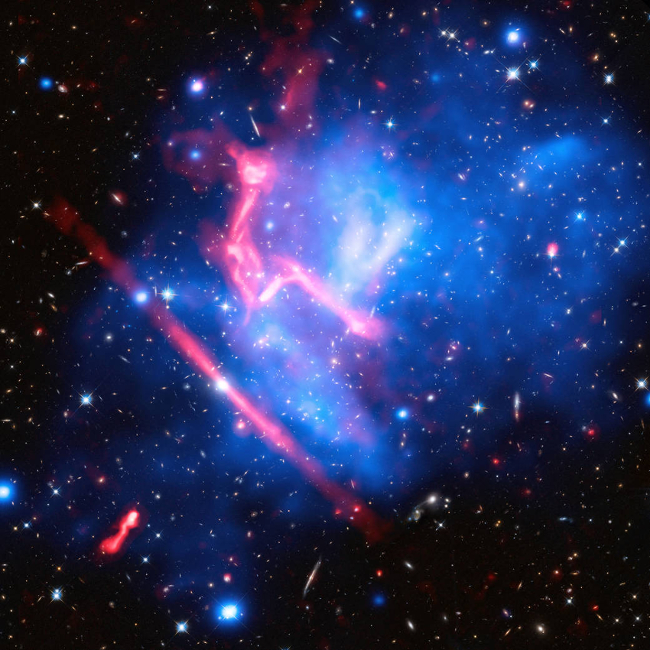
 Credit: X-ray: NASA/CXC/SAO/van Weeren et al.; Optical: NASA/STScI; Radio: NSF/NRAO/VLA
Credit: X-ray: NASA/CXC/SAO/van Weeren et al.; Optical: NASA/STScI; Radio: NSF/NRAO/VLA
The Wild Frontier
Gigantic galaxy clusters are the basic building blocks of the large scale structure of the Universe - the Universe's "atoms". Clusters of galaxies are groups of hundreds or thousands of galaxies, all bound together by the glue of dark matter's gravity. Galaxy clusters grow and change by swallowing nearby galaxies and neighboring clusters. Understanding the way galaxy clusters evolve and change is fundamental to understanding the evolution of the Universe as a whole. To help understand the details of how clusters of galaxies interact, astronomers have proposed a program of long observations on some key galaxy clusters using a collection of the world's most powerful telescopes. This project, called the "Frontier Fields", provides a view of the interactions and physical processes taking place in the observed galaxy clusters across a large part of the electromagnetic spectrum. A key goal of these observations is to use the strong gravity of the observed galaxy clusters as a gravitational "magnifying glass" to detect and study other distant galaxies far behind the cluster. The image above shows one of these clusters, called MACS J0717 by astronomers, which combines X-ray data from NASA's Chandra X-ray Observatory (in blue), optical data from the Hubble Space Telescope (red, green, and blue), and radio observations from the NSF's Jansky Very Large Array (diffuse emission in pink). The X-ray data reveal interactions in extended, very hot gas trapped within the cluster's gravitational well, while the optical data from Hubble allow astronomers to detect those background galaxies whose light is bent, distorted, and amplified by the warped spacetime around the cluster. The optical and radio data let astronomers examine distant, lensed background galaxies to determine important properties like star formation rate and sumpermassive black hole activity as a function of cosmic distance, and thus cosmic time.
Published: March 21, 2016
<
HEA Dictionary ● Archive
● Search HEAPOW
● Other Languages
● HEAPOW on Facebook
● Download all Images
● Education ● HEAD
>

Each week the HEASARC
brings you new, exciting and beautiful images from X-ray and Gamma ray
astronomy. Check back each week and be sure to check out the HEAPOW archive!
Page Author: Dr. Michael F. Corcoran
Last modified Monday, 26-Feb-2024 17:35:26 EST


